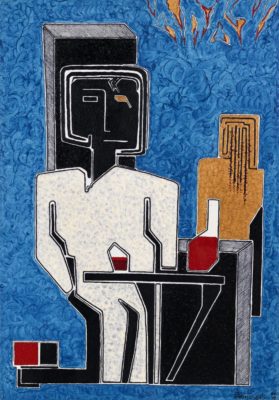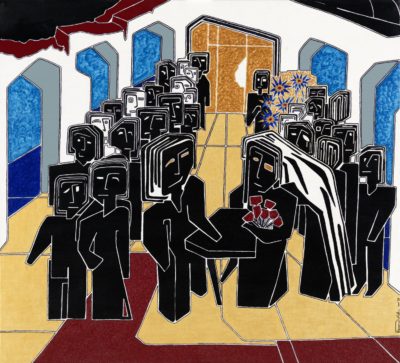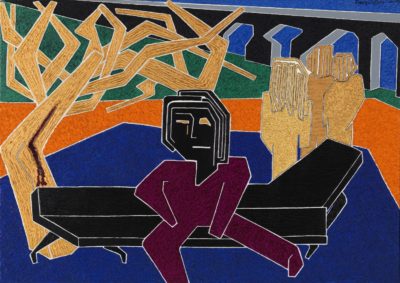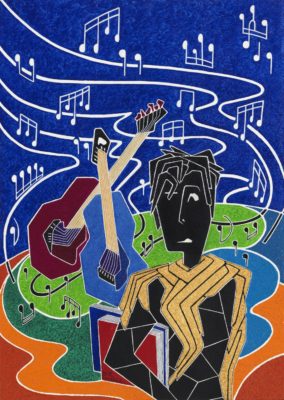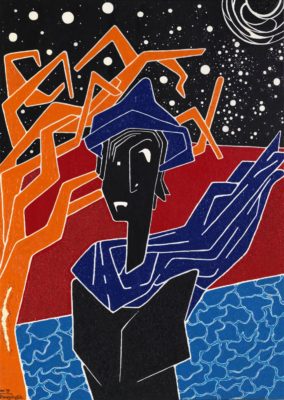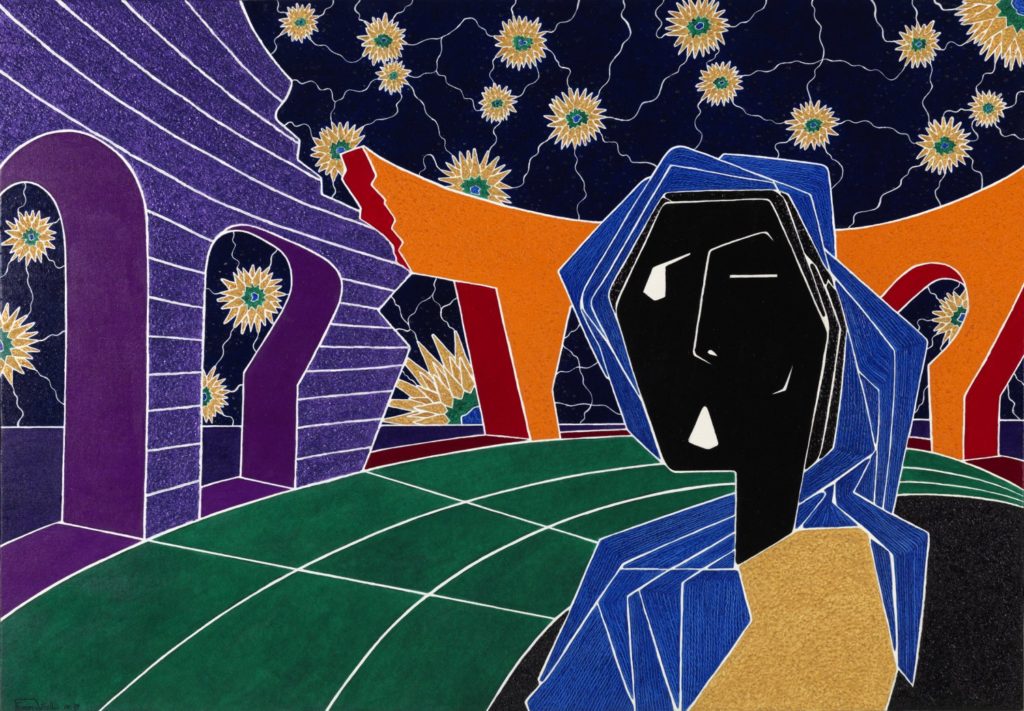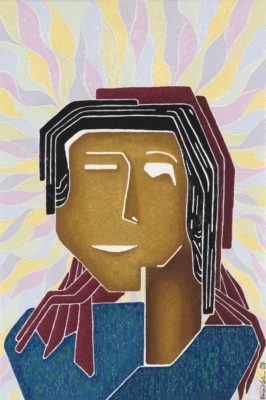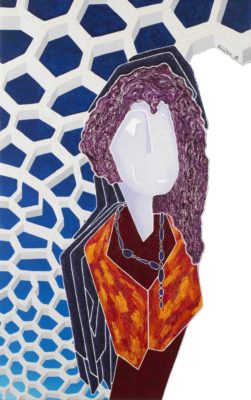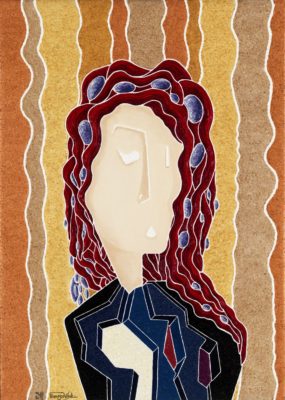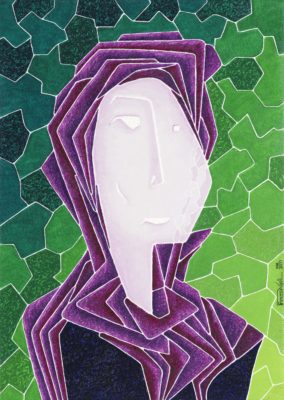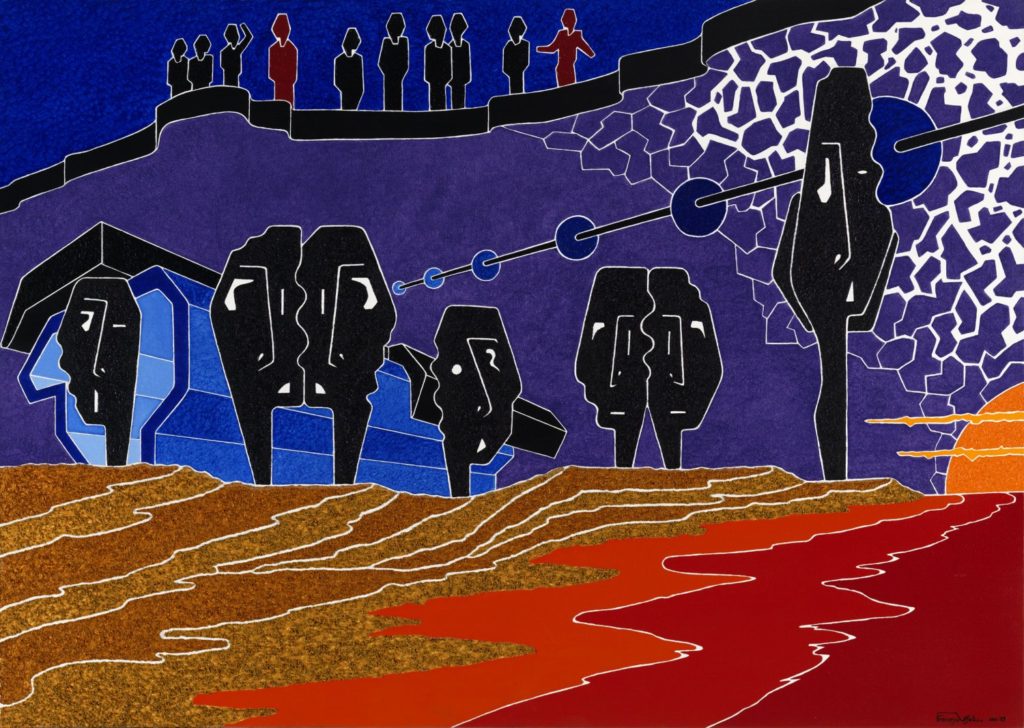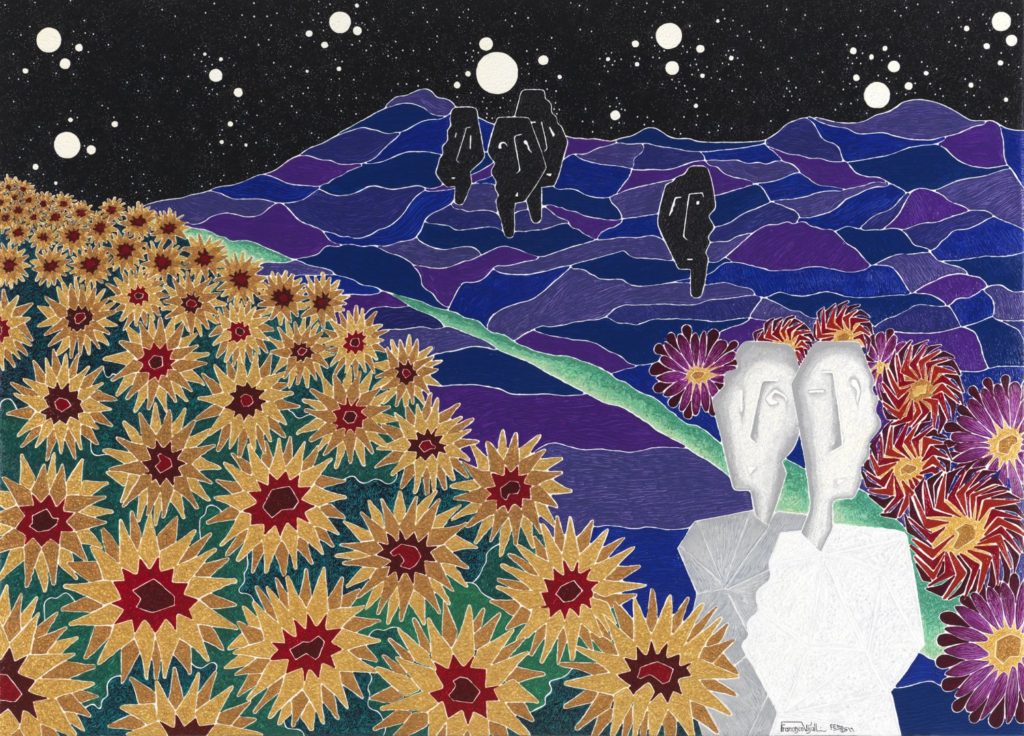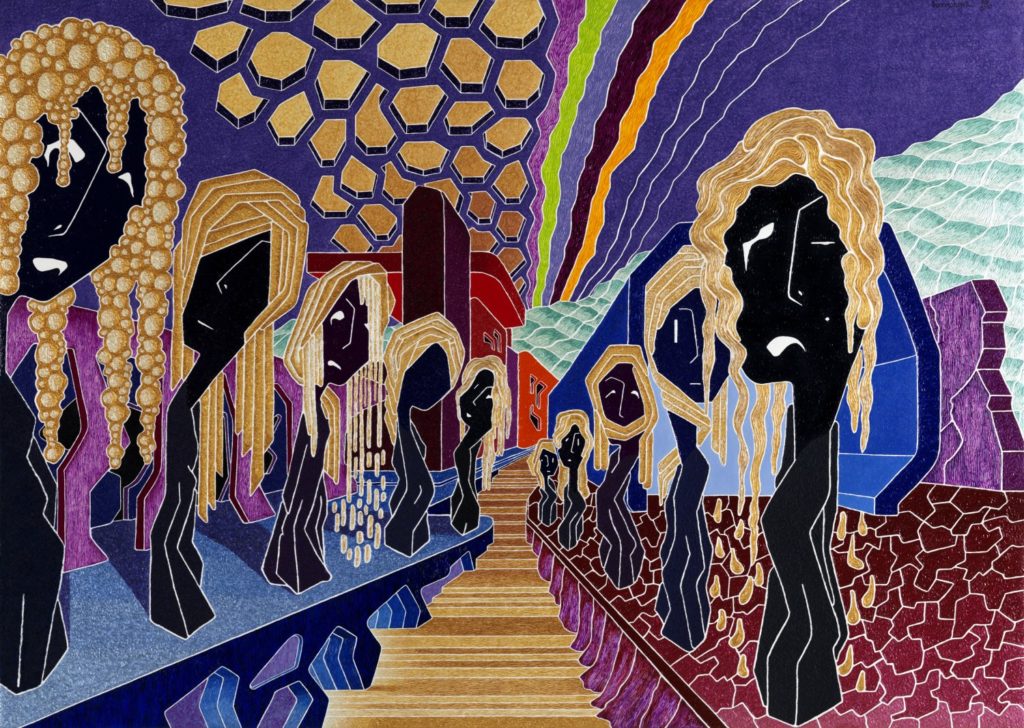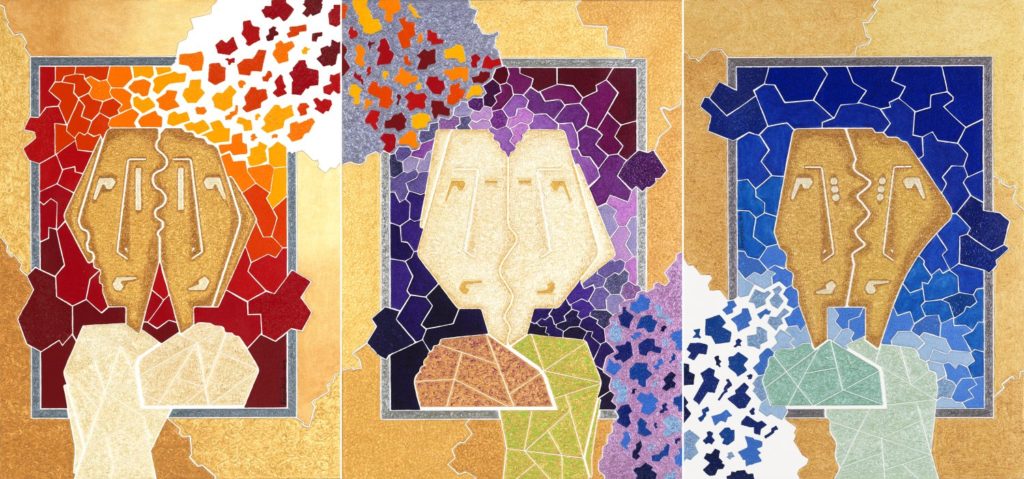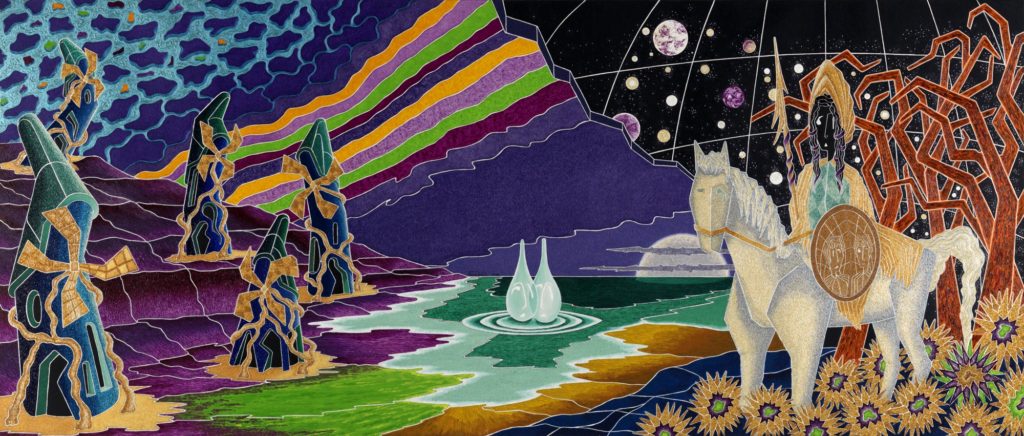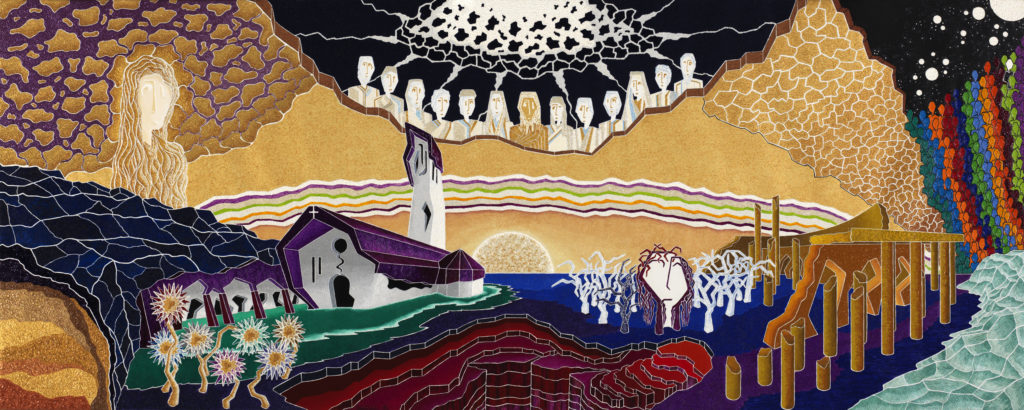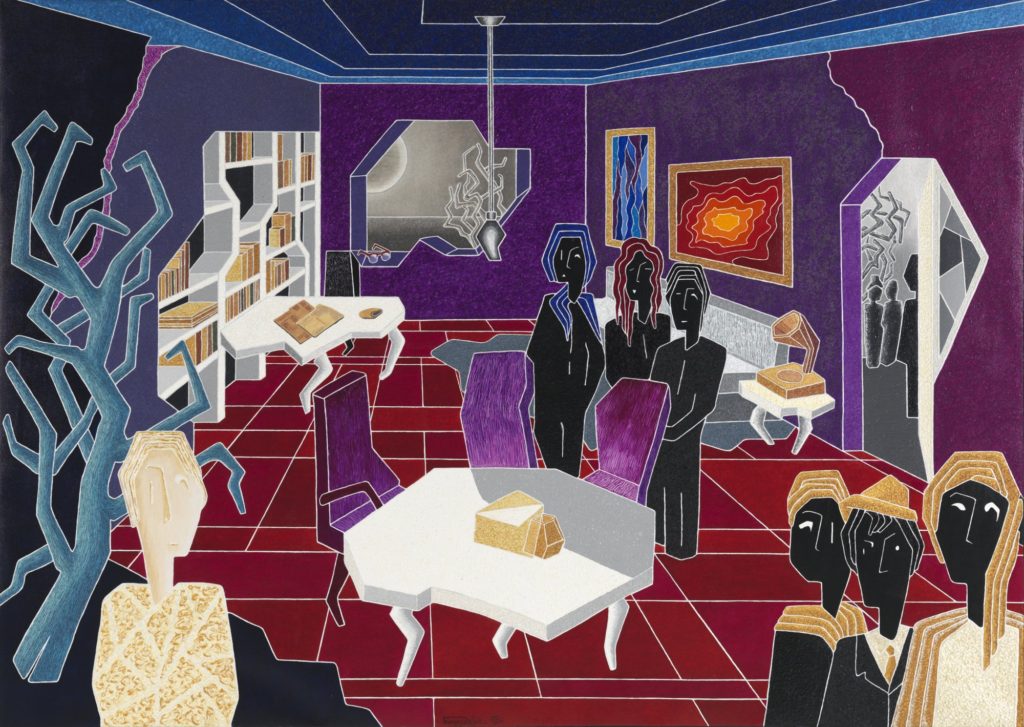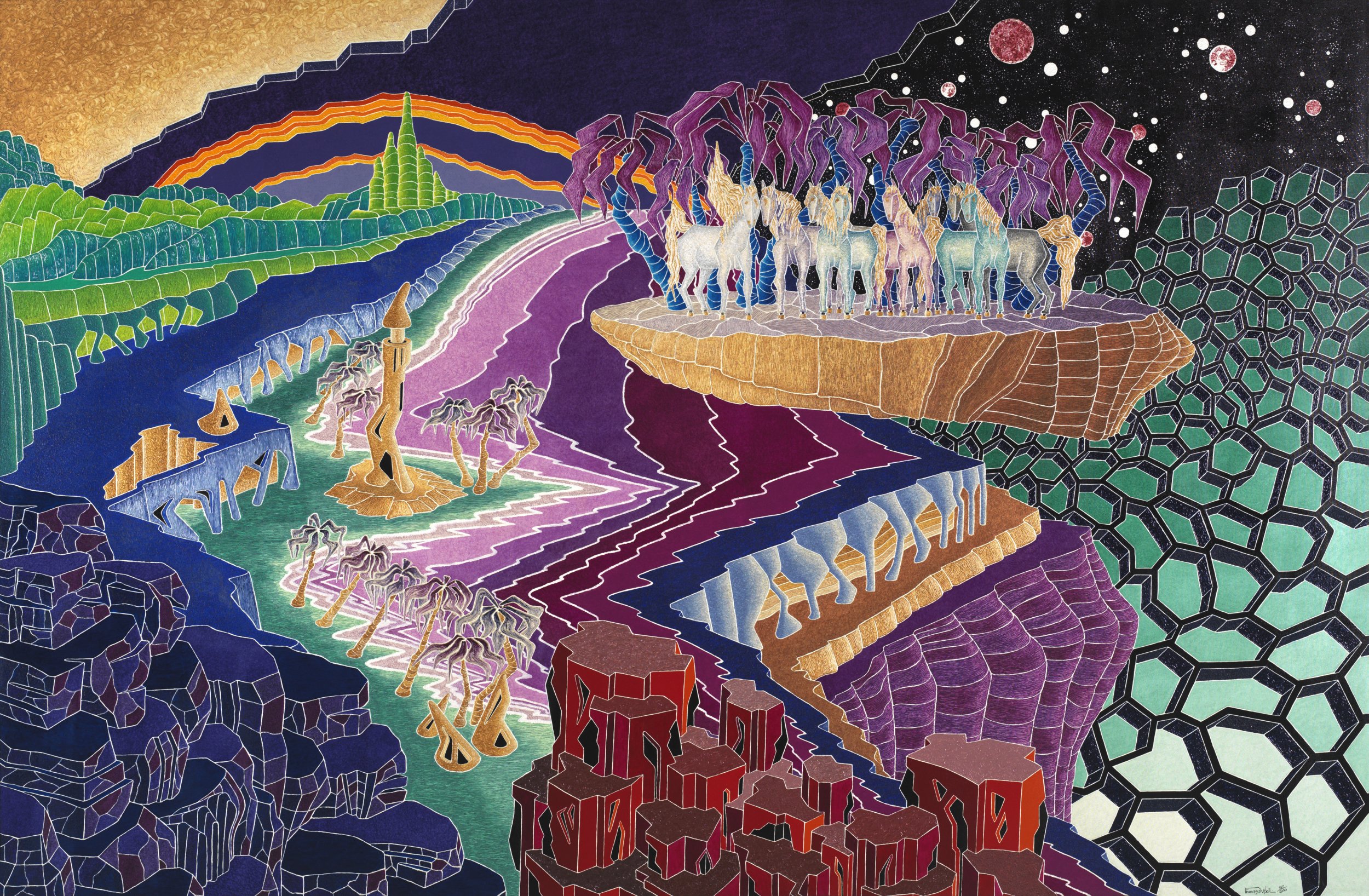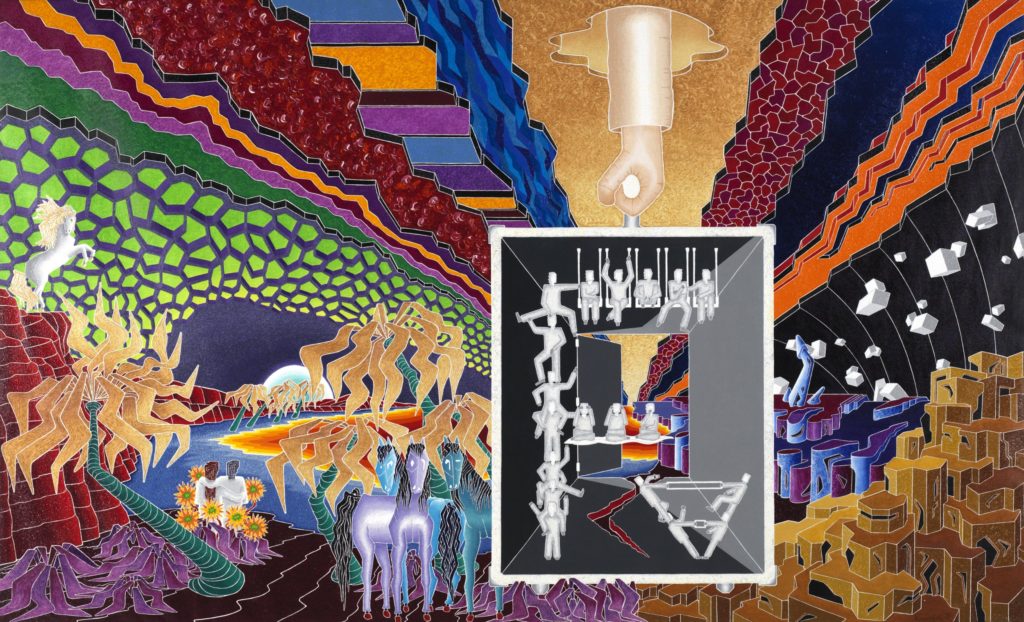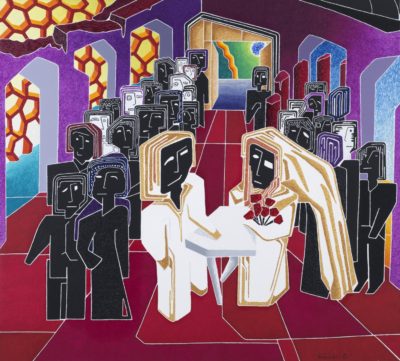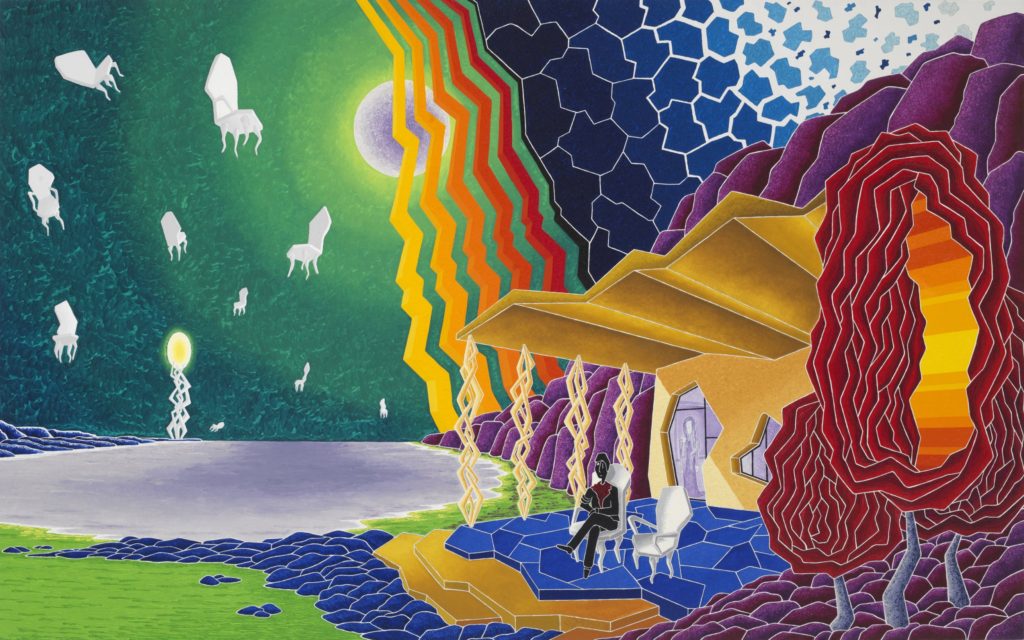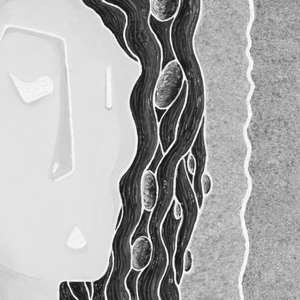
Critic Text by GIULIA LEPORATTI and GIOVANNI FACCENDA for individual paintings
Osteria / tavern
There are superimposed layers of «solitude» in the isolated room depicted in the Tavern. Geometric, linear shapes, set against a backdrop in a single colour, break away from the decisive brush-strokes of the blue ground, emphasizing the detachment of the subject’s existence from reality. A single man seated at a table, facing a bottle and a glass of red wine, seems to be withdrawing into a personal agony, underlined by the darkness of the chair which looms over him and permeates the surface of his face. Even the pure white of his body seems illusory in its appearance, when the colour which yields to the swirling brush-strokes breaks up to reveal the underlying blue. In the background, a vague, luminous figure is shown, whose only relationship with the subject of the piece is possibly an echo of colour reflected in his eye, which drifts downwards in a way almost suggesting a tear. In the top right hand corner, red and ochre-coloured flames break into the watery backdrop like hot sparks: symbolizing thoughts being drowned in the fumes of alcohol.
Le nozze / the wedding
Two lives pledge their love for each other in front of their nearest and dearest, in a space which has taken on a sacred quality to celebrate this eternal bond. We are summoned to be privileged witnesses of this vow, the only ones to see the golden sparks in the couple’s eyes, while the guests are arranged behind them in lines following the diminishing perspective of the paved floor. The road which will lead these two united souls to their eagerly anticipated life together opens up, and those desires for a bright future are crystallized in the doorway in the background. The black and white of the figures is subtly brightened by the bride’s bouquet and the floral decoration on the right. The splashes of strong turquoise between the arches in the background provide a fresh lively atmosphere, reflecting the feelings of the lovers. The intensity of the moment is uncontrollable; it breaks the construction on the left, staining it with red, the colour of passion. Nevertheless, this rent in the fabric, together with the white of the broken door, are simultaneously means of access for that element of doubt that can only really be suppressed by a bond forged over time.
Rimpianto e Speranza / regret and hope
Once again, Visalli constructs a scene which requires the participation of the onlookers. The invitation to enter the emotional dimension of the work is extended by the main figure seated on a bench in the foreground. His purplish body is twisted in an attitude of suffering; his expression is shattered by thoughts of lost time, with a golden tear running sadly down his black face. The bench forms the barrier to a state of mind from which the three figures behind are excluded. This sense of division is underlined by the difference in colour: sombre tones for the being afflicted by regret; gold for those exempted from his solitude. The composition of the work is distinguished by an extraordinary balance of colours, with blue and black framing the scene, while warm oranges and ochre leap out at us from the central section, extending into the branches of the tree. It could be just this which constitutes the hope of rediscovering happiness, of symbolically tapping into that vital sap provided by the bark of the tree, and of following the geometric branches towards the blue unknown revealed between the arches.
Musicista Letterato / literate musician
Visalli has appointed the Scholar musician to sing an ode to art, and to the culture which sustains all forms of expression. The subject in the foreground has two books under his arm, reminding us of the study required for proper artistic output; hes uncombed hair of someone who has no time for tending his external appearance because he is completely dedicated to a creative inwardness; and a golden cloak to signify his originality. Behind him, two guitars give voice to his brilliant thoughts, while the notes flutter in the sky, furrowed by the sinuous lines of an imaginary stave. The composition rises from a solid base where the principal figure is standing. From here, reality turns into a projection of the imagination, where invention materializes in a space full of colour, the perfect environment for nursing the new-born melody. Above, the blueness is split apart by the free musical element, emblematic of the spirit soaring during a powerful symphonic performance. The scene is therefore the joyful testimony of a man who fulfils himself in Art, the true monarch of his inspiration.
Poeta Errante / wendering poet
The silent wind shakes the bare branches of the tree and lifts the scarf of the Wandering poet. The setting of a «galactic» night is the non-place in which the figure is impelled to wander in search of true inspiration. Backdrops painted in single colours extend between shapes outlined in white; distinctive planes which interlock to give vitality to this highly expressive composition. The stars, a series of white dots of varying sizes, perforate the sky and give a hint of depth to a painting without the usual indications of volume and space. Visalli pushes the colours to their maximum flatness, in order to recreate the feeling of loss that the figure has chosen to endure, wandering aimlessly though the night. Three horizontal bands divide the canvas: at the bottom, the blue strip suggests the poet’s path along a stony road; the red in the centre is a burning landscape which attracts the eye; the sky is bright, allowing the traveller a little light for his journey. The figure is preparing to move on again, but the orange tree seems opposed to such an idea and stretches its branches to the moon.
Colazione da Tiffany / brekfast at tiffany
The cinema classic prompted the artist to reflect upon contemporary life, where the appetite for wealth is a desire which can never be wholly requited, leading to a constant state of dissatisfaction. The subject of the painting is seated at a precious purple-coloured table, on which the objects she is prepared to possess are set out. There is a clear reference to Hepburn in the black sheath dress and the gloves white by contrast, but above all in the unmistakable cigarette holder, which Visalli paints in vivid colours. Alone, next to an empty chair, she is smoking- turning her back on two enigmatic figures who seem to be her accomplices. They regard her with a degree of envy for her rich appearance, ignorant of her inner sadness and emptiness. The internal setting is dominated by bright colours, an effective means of illustrating a dimension that is wholly external. By contrast, there is another world screened out by the yellowish windows, where fantastic images blend into the single tone. This is a reality made up of ordinary people, greedy for riches, but ignorant of the pettiness of this artificial happiness.
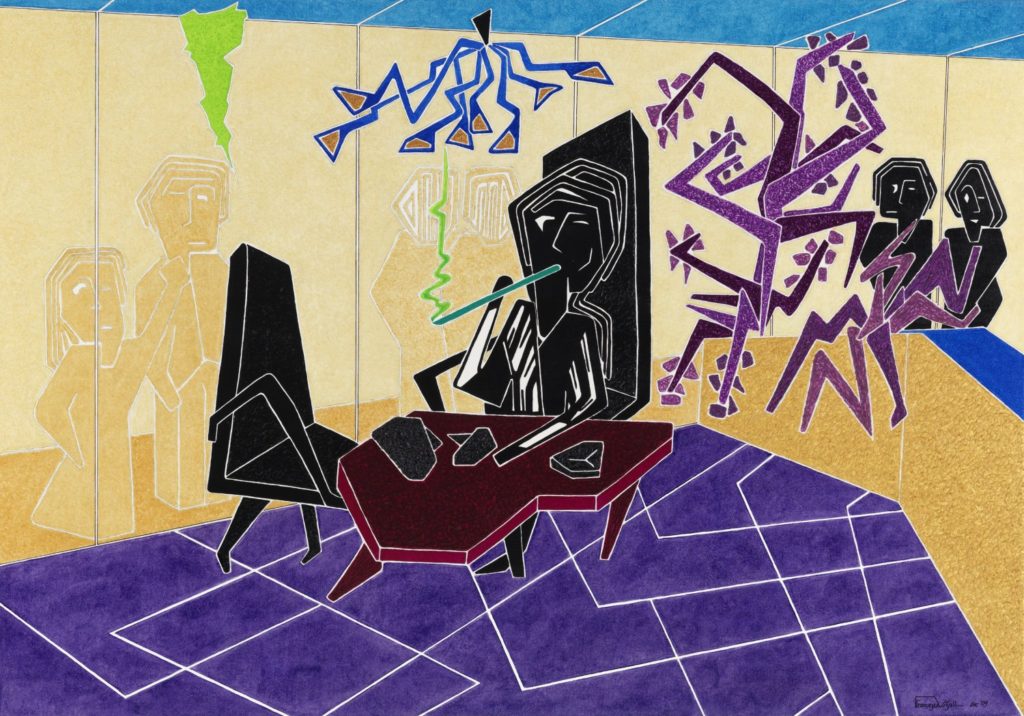
Paesaggio 1 “Il Borgo” / landscape 1 “the village”
All of Visalli’s creative originality is on display in his wide-angle vision of The Village. Adopting the example of great paintings of ideal cities, the artist dentifies a central vanishing point which helps give rational organization to his visionary progect: a small green semi-circle poised on the horizon appears to be the sun, giving order to the scene and lighting up the sky with a magical green sunset. From here, the composition is built up in a spinning pattern which structures the design, multiplying the elements within it towards the extremities of both sides. The little village is a mosaic of red and orange tiles, crowned by blue roofs like pagodas, and disappearing into the distance along the banks of a small stream. On the flat blue expanse stand a series of crooked arches, and a number of violet- coloured trees with a jumble of bare branches. The birds open their wings to the wind, which we imagine accompanying them in their flight, and it shakes the vane on the tall tower, while time slowly moves the hands on the two clocks. Witnesses to a tranquil world, three smart-looking people pause on the outskirts of this imaginary village, almost as if they want to preserve the idyll.

Rimembranze / remembrances
The space in Remembrances wraps around us, like a memory that lingers on. The reality of the person in the foreground surrenders to the inner depths of a mental state to which Visalli has free access. The individual’s thoughts are transformed into shapes and colours, exemplifying a situation not exclusive to the subject but objectively attributable to each one of us. A series of arches, from violet to orange, is an archetypal structure with an almost sacred aura, the basis of a common past indicated by the cracks of time, perpetuating its identity into the present. There are many gateways opening onto the blue background, from which to draw reminiscences or project future dreams. The green wake curving behind the figure is the «grassy» terrain of closest memories, while the dark sky is not lit up by stars but interwoven with a network of yellow flowers, constellations of moments of remembrance. The circular movement of the composition suggests cohesion is established between personal experiences, collective memory, and the present experience of the subject of the work.
doppiezza / duplicity
Visalli expresses a typical dichotomy of his paintings in a work which itself is an image of human dualism. Substance and appearance, will and duty, divide both the figure and the surrounding space. On the right, everything is carefully laid out and precise: the blue face has a serene, composed expression; the loose hair is coloured a delicate mauve, tumbling onto a purple breast decorated with white curving lines. On the left, on the other hand, the order is shattered: the colours become dark and the shapes more angular; the red mouth is open in a grimace which contorts the cheek and raises the cheekbone; the hair is torn apart, reducing the rich tresses into shreds on a flat backdrop. The body is a collection of pointed shapes, whose geometric joints force the shoulder upwards, increasing the process of break-up. The background echoes the expressions of the two halves: gently waving lines vibrate in harmony with the gold on the right; while on the left, the ochre descends into brown, in an angular scale of darkening colours. Duplicity is a cry of distress, suffocated by a mask of apparent wellbeing, the inner self forced to disintegrate because it is deprived of every outlet.
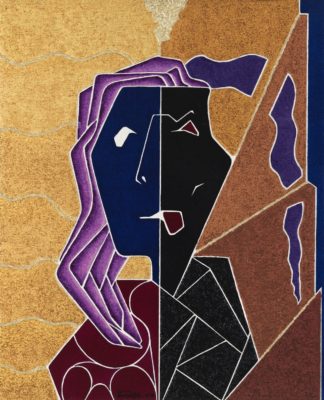
Essa / she
She is one of the pictorial studies completed by Visalli as part of a series of different female figures. The title remains vague because he does not wish to identify a precise subject, but rather to offer us one of the universal models of woman. As always, the artist has not restricted himself to a superficial observation, but has expressed a much more complex concept of inner identity on this canvas, indicated by specific external characteristics. The smiling expression of the subject certainly makes us hope that she has reached a state of psycho-physical equilibrium. The shapes and colours in the background seem to confirm this: strangely delicate compared to the artist’s usual palette, radiating outwards in subtle flames towards the edges of the picture. They make a sharp contrast with the definite colours of the figure, whose glowing brown skin lends an atmosphere of reassuring Mediterranean warmth. Visalli, however, does not fall victim to facile interpretations, and enriches the work with some new questions: in fact, that typical double life of many of his characters resurfaces here, in the hair that turns from black to reddish purple, in the eye sliding downwards, and in the asymmetric breasts framing the long, thin neck
Ella / she
An image rich with contrasts reveals the complex nature of the new type of woman to whom Visalli has dedicated this portrait. The background, made up of geometric honeycomb shapes, a familiar tool of the artist, leads us to a dazzling white space. This leaves open future possibilities but, at the same time, seems to devour everything that has been put down on the canvas. The body of She is an outline without arms, although she is still allowed certain external details: such as the shawl over her bordeaux dress, a hint of real warmth in a sea of cold tones, and the necklace of blue stones, a precious item of jewellery which hints at her feminine elegance. The features of the face are composed of thin, ambiguous lines, which merge into the icy pallor of the skin, covered by the thick mane of violet hair. This also displays an asymmetry, which demonstrates the profound dualism, already encountered in the split characteristics which typify Visalli’s subjects. Nevertheless, the expression on the face seems generally tranquil and, despite the apparently irreconcilable empty space, the background, viewed though the white lattice-work, gives us glimpses of a clear blue sky.
Lei / she
The fascination of a seductive type of femininity is tinged with mystery in a face whose features are just hinted at in She. The pinkish flesh revealed between the geometric lines of the breasts is a hint of delicate nudity amongst the confusing overlapping of the various planes. From black to blue, through red and violet, the figure’s breast-plate is built up in a perspective which is not fully discernible in the colours that Visalli applies in fluid, sometimes solid, strokes, exploiting all the effects the brush can afford him. There emerges the portrait of a woman who is both strong and secure in her physical being, casually unleashing the thick red mane of her hair in a cascade of soft tresses, studded with blue stones. The background looks like a «pattern-book» of types of sand and clay, presented in thick wads of colour, the earthly setting from which so much beauty has sprung. Again, we find ourselves drawn to the «bipolar» nature of the figure, in the joint presence of the cold and hot elements, and of the angular and supple forms with which Visalli has modelled a profound and complex being, leaving us once more on the edge of total comprehension.
Colei / she who
Visalli pursues his investigation into female portraiture and reaches a new pictorial goal in depicting that introvert and enigmatic character which so typifies his female figures. “She who” gives us the impression of a fragile woman who is trying to conceal her weakness behind a mask of imperturbability. Her mane of hair, painted in pleasing shades of violet, is so long that it envelops her neck, transforming her locks into a soft turban which wraps her head and shoulders in an intricate scheme of folds. The background is a mosaic of irregular pieces: a network of green fragments starting with dark shades in the top left-hand corner and descending through a range of lighter shades to the opposite side. The surfaces seem to pulsate, due to the manner in which the artist has applied his material, alternating areas of flat colour with others where one can clearly see the brushwork. The process of shattering seems gradually to assail the subject herself, starting with her cheek, which already has a scaly appearance. Perhaps it is a sign of certain hurtful experiences which have damaged the subject’s personality through her face: scars which disfigure that part of the body in which each of us fully recognizes his own identity.
Visioni 1 “Isola del Tesoro” / vision 1 “tresure island”
Certain exotic suggestions invade Visalli’s imagination, landing these stately figures in the dreamlike landscape of Treasure Island. The space within the work is revitalized by sudden changes of scenery and experimentation with multiple points of view which break down the barriers of our typical mental constructs. The time required to explore the surface of the painting is nevertheless insufficient to allow us to identify a dominant perspective, as the scene has a strange quality of fluidity, like the ideas of the visionary artist who created it. The palette is a contrast of warm and cold tones, which split the composition in half, pursuing that dualism to which Visalli has accustomed us in the form of divided colours. The red and orange sunset gilds the defensive shoreline of these modern Moai and becomes an underworld paradise for anonymous individuals, spectators and, at the same time, actors in the scene, who are standing on the perilous edge of a slowly crumbling precipice. The story continues through a landscape crowded with memories tied to a black line interspersed with blue spheres. This pipeline leads into the «urban» setting of a tunnel under construction, another road to a destination as yet unknown.
Visioni 2 “Notturno di Girasoli” / vision 2 “night of sunflowers”
A limitless expanse of flowers borders the sideways tear through the painting, which seems to expand beyond the limits of the canvas towards a universal sky. The landscape of the soul can contain many possibilities, and Visalli offers us scenes of ever increasing breadth for visions which aspire to a timeless condition. Night of sunflowers displays a dichotomy which is central to the compositional balance of the picture. The thick floral «carpet», irrigated by parallel furrows fed by the pure waters of the stream, is offset by a corresponding «irrational» landscape, composed of little rises and depressions only covered by vegetation in one corner. This double reality is also reflected in the figures who live in it. In the foreground, two inseparable souls appear to be carved from rough crystal, their solid forms covered in geometric facets which absorb the moon’s rays and make them sources of a faint luminescence. In the background, monolithic totems with black faces stand in the empty land of the violet background, bearing the same facial expression that unites all the figures of the mysterious night, as beings with parallel spiritual dimensions.
Visioni 3 “Ex Viale” / vision 3 “former avenue”
The scene of “Former avenue” opens in the depths of a tunnel, with vibrant colours and pleasing forms. There are no ancient trees lining the street, but instead some figures of women with vaguely outlined bodies and elaborate hairstyles, like bare trunks that have sprouted luxurious gold crowns. Each of them seems to be awakening from a state of passive immobility to observe whoever wishes to undertake the visionary journey that Visalli offers us. The sad faces speak about far-off memories, perhaps in reference to that “former” of the title, recalling something that exists no more. The stairway, which leads us towards futuristic buildings in the mysterious central perspective, is a symbol itself of a journey through the layers of the soul, represented by an alternating pattern of multi-coloured shapes. In the sky, a reassuring rainbow leads us to our destination, flanked by a brilliant honeycombed surface and by a wall of soft crystalline fabric. The contrapuntal colours of the diagonal surfaces are wonderful: the blues on the planes and the reds of the constructions on the left reflect each other in an inverted «puzzle» and in the outlines of the wall on the right. It is a highly original composition, to which Visalli devoted all his expressive creativity.
Pan d’oro
The original choice of such an «extreme» shape was in response to the needs of an evidently symbolic work. The ascending motif on which all the forms of the composition are arranged takes on a greater expressive significance as a result of the vertical shape of the canvas. The Pan d’oro constitutes the plinth for the human tower of acrobats, topped by the pointed ornament normally used to decorate the Christmas tree. A thick bed of flowers surrounds the celebratory cake, giving way to an arid violet landscape which stretches into the background. The network of many figures follows a gradual evolution of colour, from warm tones at ground level to the light blue of the sky and the indigo of night. Among the rising forms appear a number of golden objects like baubles, symbolic of daily life and of growing prosperity, as in the traditional horseshoe and the modern symbol of the Euro. The sky also participates in the ascent undertaken by the multi-coloured team, changing from deep blue to the delicate shades accompanying the free flight of birds.

Anima Gemella / twin soul
The triptych is the pictorial outcome of a reflection on symmetry, in relation to bodies which reflect each other spiritually, and the corresponding formal elements of the composition. The use of the fragment as a constructional element is a choice which relates to the magic in a meeting of two souls bound together in a perfect union. The backdrops for the portraits of the three couples are composed of red, violet and blue pieces which spill over into the space of the adjoining lovers, further emphasizing the feeling of union which permeates the entire composition. The features of the characters are just lines eroded into the coloured surface: heads deprived of any personal characteristics which melt into the same thought. The bodies are sketched out in numerous facets, and one in each couple spills outside the frame, perhaps hinting at a desire to escape a little from an existence lived exclusively in relationship with the other. The geometry dominates the structure of the work, delineates the features of the subjects, and controls by its lines every slightest change of tone.
Alba di Madame Chisciotte / madame quixote’s dawn
This work is a reinterpretation of the woman in the classic story by Cervantes. The subject is indeed the heroine astride a white steed, posed in front of an unfolding multi-coloured landscape ready to offer her many different routes to adventure. The intrepid figure is dressed in gold and brilliant green, wearing a hat like a sculpted turban from which strands of hair interwoven with violet ribbons escape, which also decorate her shining lance. Madame Chisciotte has the attraction of a Renaissance warrior, wrapped in her ample cloak, and protected by the images of her family impressed into her shield. She is a positive individual who has left the dense forest of skeletal trees behind her, and is following a colourful road strewn with flowers. Awaiting her is a «liquid» dawn, diffusing its light into the colours of the water and into the sublime fusion of the two drops, the symbol of love right at the centre of the canvas, and the perfect omen for the start of a long journey. The windmills look like witches in their sinister contortions, but the protagonist does not seem to fear them. The sky is divided between an «astronomical» grid against a black background and a rainbow firmament above the imaginary, unexplored world into which she will make her triumphal entry.
Infinita Storia d’Amore/ endless love story
There is no loving couple to populate the Infinite Love Story but rather an assemblage of symbols relating to Christian spirituality, and faith in the love of God over the millennia. The mystical landscape is dominated by the intensity of the gold, illuminated in the true light of the sun on the horizon and in the iconic female figure on the left. She seems half-way between the Virgin Mary, pure and gentle, and the penitent Mary Magdalene, with her soft, shimmering hair, reminiscent of Donatello’s sculptures. The sky of the Last Judgement shakes the heavens behind the twelve Apostles who, together with Jesus, face the open abyss in the red layers of earth and gaze into the depths of an underworld from which they are morally far removed. The rainbow on the right turns into a mass of humanity, colouring the many figures who share a common history of symbolic interpretation: the church, the cross, the destruction of the pagan temple. In the gathering of the faithful, there is an intrusive figure painted in black and white, the discordant note which Visalli always includes, and which affirms once again his intention to provoke a debate.
La Stanza del Suicida / the suicide’s room
The canvas transforms the words of the Polish writer into images. Visalli uses the intensity of the poetic text and paints a room full of objects and people which is dramatically silent because of the envelope that the victim has left empty, right in the centre of the picture. It contains the items described by Szymborska, like the three chairs with strong back-rests, the paintings and the books. There are ways out of the room, the door and the window, but the view they offer is one of depressing greyness of a tangle of dead branches. You can feel the sadness in the faces of his friends and their incomprehension at such an extreme gesture: the loss of words in those who Visalli has symbolically depicted without mouths. The artist has used mainly violet tones, alternating with the lightness of white and ochre, obtaining a balance of colour which serves to evoke an atmosphere still suspended between life and death. It is possible that we can see the soul of the dead man in the shining figure Visalli has placed in a corner on the left, set against a broken black ground with a bare blue tree: an otherworldly spectator with unexpected human warmth, sadly arriving too late.
Caos Cosmico / cosmic chaos
The Cosmic chaos that Visalli depicts on the canvas in fact implies a superior order, which regulates the simultaneous presence of various spatial islands by means of a formally balanced scheme of colours. The composition appears to be the result of a multi-coloured “horror vacui” (fear of emptiness) in which the combination of warm and cold tones floods the background with light and gives a shimmering appearance to this floating world in formation. The colours fill the various layers of an imaginary earth’s crust not yet put to order, which alternates naturally formed landscapes with arid rocky scenes. Horses with pearly coats and golden manes stand under the violet palms of a floating oasis; a crooked tower rises on a strip of green which becomes increasingly bright and vibrant as it rises in hillocks towards the gleaming, golden sky. In the foreground, stand two huge rocky masses, one blue and the other red: they are cut into numerous facets, perhaps mined from deep caves which may be inhabited by primordial creatures. On the right, all becomes simpler in the green tones of a honeycomb network leading into the depths of a starry night, the corner of the universe which is the arena for this continuous cosmic flux.
La Valigia / the suitcase
Visalli pushes his interior investigation to the limit, offering a composition in which the typical dichotomy of his works gives way to an entirely symbolic space. The Suitcase is held by a large hand descending from above, perforating the final layer of the dimension in which it reveals its contents, opening onto the multi-coloured strips that radiate outwards from the central perspective. The grey walls of the case give it a cold, ascetic appearance, and in it the shapes of little men combine to form the artist’s initials: “FV”. Three of these figures adopt the poses of see, hear, and speak no evil, perhaps symbolizing the incapacity to communicate which characterized the past history of the artist. His negative experiences are locked in the «metallic» core of the representation: wounded with red but opening onto the vibrant scenes of hope. On the left, an exotic paradise inhabited by horses provides the romantic setting for two lovers embracing in front of a luminous dawn: on the right, there is a world in construction, the building blocks of a new inner world in construction, with solid white bricks still floating in the air. The personal journey undertaken in the work continues its course by following the strips of multi-coloured sky towards a future open to the imagination.
Le Nozze “2” / the wedding “2”
Visalli offers a new version of “The wedding”, enlarging the dimensions of the canvas, introducing colour variations but leaving the compositional design intact. The couple maintain the same pose, but are wearing white clothes, lit by gilded reflections of orange and ochre; similarly the guests, whom the artist has adorned with some aesthetic touches, some curls amongst the hairstyles, and some notes of colour to enliven the group of black and white figures. The colour scheme has been enriched with warm shades and shining tones inside the building and in the scenes that open up between the arches, abandoning the original basic quality to develop the more lively and passionate nature of the emotions celebrated in the work. To the right, the blue extends into the harmony of the clear sky, while on the left a honeycomb pattern is lit by colour, intensifying the effect of the unstoppable force that has shattered the building, revealing a wide area of brilliant red. The two extremes in terms of colour and formality, symbolic of the complexity of the eternal bond, achieve a balance in the landscape revealed through the front door, finally open towards the future that the two souls have decided to share together.
Attesa / waiting
The painted surface shines with a new airiness, aided by the cut of the composition that opens up in the brightness of the moonbeams. The dual nature of the work unfolds under the pale purple star, poised between the lightness of the white chairs suspended in the green sky on the left and the complex geometry of volumes that cross through the background on the right. A pond framed by rocks is the panorama facing the figure sitting on the porch. We feel time passing by with extraordinary slowness, waiting for something or someone to occupy the empty chair. Behind the man, a fragile female presence goes unnoticed, standing behind a window with purple hues. The scene expands in the suspension of the moment that precedes the meeting between the two protagonists, fuelling the plot of the unknown. Delimiting the spatial depth, two elements mark the boundaries of an imaginary diagonal perspective; on the horizon the shining oval seems like a lamp on an eccentric electric trunk while the red foliage in the foreground reveals a “ladder” of colour with warm solar shades, perhaps the harbinger of expected happy times.
